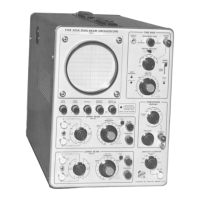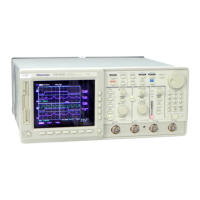Circuit Description— Type 544/RM 544
the output of the regulated + 100-volt supply tries to de
crease, the reduced voltage at the top end of R650 permits
the voltage at the junction of R650 and R651 to go more
negative than the normal — 1.7 volt level at that point. The
increase in negative bias on the grid of V664A reduces the
flow of plate current through V664A, the voltage drop across
plate load resistor R663 decreases, and the plate voltage of
V664 and the grid bias of V677 go more positive. As the
grid of V677 goes more positive, the resistance that Vd77
offers to the flow of current is decreased and the output
voltage rises, compensating for the drop in output voltage
which initiated regulating action. Of course, the regulator
circuit can never completely compensate for a change in out
put voltage, for there must be an error input for the circuit
to operate, but any error in output is reduced by a factor
equal to the loop gain of the regulator circuit.
The screen grid of V664 is used as a signal grid for injecting
a sample of any ripple or transient voltages present in the
unregulated side of the + 100-volt supply into the regulator
circuit. The regulator circuit thereby becomes a dynamic filter
for ripple reduction. The ripple signal is applied to the screen
of V664A, amplified and inverted in phase by V664A, then
applied to the grid of V677. By the time the amplified and
inverted ripple gets to the grid of V677, it is of proper ampli
tude and phase to cancel out the ripple appearing at the
plate of V677.
To keep the proper load on the + 100-volt supply when
the vertical plug-in preamplifier is removed, a plug-in sensing
switch is built into the main frame of the Type 544 at the top
rear of the plug-in compartment. When the plug-in unit is
removed, the sensing switch connects a resistive load in place
of the series-filament string. When it is desired to operate
the plug-in unit outside the Type 544 by means of a test
harness, the sensing switch must be manually operated. To
manually operate the switch, pull the plastic plunger outward
to the stop position.
Unregulated + 325-Volt Supply. The unregulated -1-325-
volt supply voltage source differs somewhat from the voltage
sources for the —150- and + 100-volt supplies. A center-
tapped secondary (13-14-15) on T601 and silicon diodes D702
and D732 form a center-tapped bridge rectifier circuit with
the negative side connected to the positive unregulated side
of the voltage source for the + 100-volt supply. The unregu
lated + 325-volt output is taken from the transformer center-
tap (14) connection.
The unregulated output of the voltage source for the
+ 100-volt supply is approximately +180 volts. The unregu
lated output of the center-tapped bridge circuit is approx
imately + 290 volts; this, added to the unregulated +180
volts provides the +470 volts. However, for the unregulated
+ 325-volt output, the connection is made at the center tap
( + 145 volts) of the bridge (the midpoint of the +290 volts).
Adding the +180 and +145 volts provides the desired out
put of +325 volts.
+ 225-Volt Supply. The voltage source for the regulated
+ 225-volt supply is the unregulated + 325-volt supply de
scribed in the preceding paragraphs. The regulator circuit
is similar to the regulator circuit found in the —150-volt
supply; the main difference being that instead of using a
glow discharge tube as a reference voltage source, the lef-
erence voltage is from the —150-volt supply. The error signal
is picked off the junction of precision resistors R680 and
R681. The upper end of R680 is connected to the + 225-volt
output, and the lower end of R681 is connected to the regu
lated —150-volt supply. The voltage at the junction between
R680 and R681 is approximately —0.9 volt which is applied
through R682 and R683 to the grid of V684B. The cathodes
of V684 are longtailed to the —150-volt supply through re
sistor R685. The grid of V684A is grounded. The error signal
is fed from the grid of V684B through the common-cathode
circuit to the A side of the tube. Notice that this comparator
is somewhat different from the comparator used in the —150-
volt supply; the output is taken from the A side. The error
signal is amplified by V684 and fed, unchanged and in phase,
to the voltage divider in the grid of V694. V694 also ampli
fies and inverts the error signal and applies it, out of phase
with any change in the + 225-volt output, to the grid of
series regulator tube V707.
Here again, the screen of the error amplifier tube is acting
as an injection grid for ripple reduction. A sample of the
unregulated supply ripple is applied to the screen of V694.
V694 amplifies the ripple, inverts it in phase, and applies it
to the grid of series regulator tube V708. The result is that
the same ripple appears simultaneously on the grid and plate
of V707, but 180° out of phase; thus the ripple cancels out.
+ 350-Volf Supply. The input to the + 350-volt supply is
the full voltage output of the center-tapped bridge (see de
scription of + 325-volt supply) added to the unregulated side
of the + 100-volt supply. The operation of the regulator
circuit is very similar to the operation of the + 100-volt regu
lator except for different component values and no grid-
cathode contact-bias compensating diode.
Crt Circuit
The crt circuit (see Crt schematic) includes the crt, the high-
voltage power supply, and the controls necessary to focus
and orient the display. The crt (Tektronix Type T5470-31-2) is
an aluminized, 5-inch, flat-faced, glass crt with a helical post
accelerator and electrostatic focus and deflection. The crt
circuit provides connections for externally modulating the
crt cathode. The high-voltage power supply is composed of
a dc-to-50-kc power converter, a voltage-regulator circuit, and
three high-voltage outputs. Front-panel controls in the crt
circuit adjust the trace rotation (screwdriver adjustment), in
tensity, focus, and astigmatism. Internal controls adjust the
geometry and high-voltage output level.
High-Voltage Power Supply. The high-voltage power sup
ply is a dc-to-ac converter operating at approximately 50 kc
with the transformer providing three high-voltage outputs.
The use of a 50-kc input to the high-voltage transformer per
mits the size of the transformer and filter components to be
kept small. A modified Hartley oscillator converts dc from
the + 325-volt unregulated supply to the 50-kc input re
quired by high-voltage transformer T801. C808 and the pri
mary of T801 form the oscillator resonant tank circuit. No
provisions are made for precise tuning of the oscillator tank
since the exact frequency of oscillation is not important.
Voltage Regulation. Voltage regulation of the high-volt
age outputs is accomplished by regulating the amplitude of
oscillations in the Hartley oscillator. The —1850-volt output
is referenced to the + 350-volt regulated supply through a
voltage divider composed of R841, R842, R843, R845, R846,
R847, R853 and variable resistors R840 and R846. Through a
tap on the voltage divider, the regulator circuit samples the
3-4

